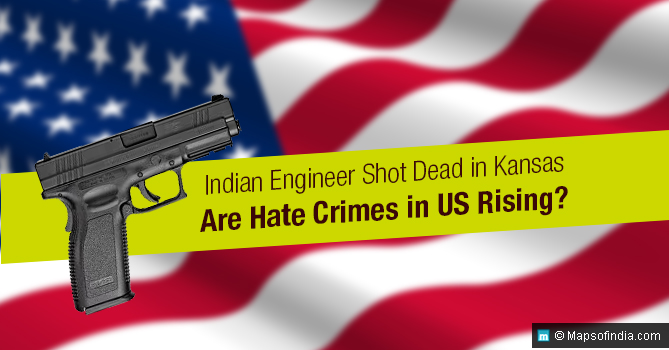The Indian community in the United States is a rather large one. Reports from 2013 said that more than 2 million Indian-born immigrants were living in the US. According to a study by Pew Research Centre, more than 87 percent of the adult Indian-Americans are college graduates. Many of them landed on American soil for higher education and stayed on to work, blending seamlessly into the society.
The contributions made by Indian doctors, engineers, IT professionals, businessmen and entrepreneurs, teachers, lawyers, and scientists towards the development of the US are dedicated and extraordinary. It is the confidence in its own abilities and worth that has kept the Indian community in the 50 states insulated from fear of persecution.
Racial Attack in Kansas
Coming as a jolt to this sense of security, one Indian engineer was killed and another shot at and wounded in a racially motivated attack on February 22, 2017, in the state of Kansas. Indian engineers Srinivas Kuchibhotla and his colleague, Alok Madasani were shot at in Olathe. Both were employees of the technology major, Gramin. Another white young man, Ian Grillot also received gunshot wounds when he tried to intervene. Kuchibhotla died at the hospital.
The shooter US Navy veteran, Adam Purinton, reportedly screamed, “Terrorist” and “Get out of my country”, before he started firing at the two. Purinton has been arrested from Missouri and charged with premeditated murder.
Even as Kuchibhotla’s body is being sent back to India, his wife has made an impassioned appeal to the US administration to put an end to hate crimes.
Hate Crimes Against Indians In The US
The FBI and the White House are reluctant to call the incident a hate crime. It is also possible that the shooting of Kuchibhotla and Madasani were a misdirected racial attack. Adam Purinton is believed to have told the bartender at the restaurant at which he was picked up later for the crime, that he just killed two Middle Eastern men. This is hardly the first time Indians have become collateral damage to the growing hostility and increase in hate crimes in the US.
Over the past 7, or 8 years, numerous hate crimes against Indians have peppered American news; the most memorable among them was the 2012 Wisconsin gurudwara shooting (which left 6 people dead). According to the FBI, hate crimes against Muslims has grown by 67 percent since 2015. Critics of President Trump have gone on record to blame him for the hostile environment and his anti-immigrant approach for having fuelled such ill will.
From Visa Woes To Newer Worries
The Indian Embassy in the US rushed to support the families of Kuchibhotla and Madasani. The Charge d’Affaires of the US Embassy in Delhi, MaryKay Carlson said, “The United States is a nation of immigrants and welcomes people from across the world to visit, work, study, and live…US authorities will investigate thoroughly and prosecute the case, though we recognise that justice is small consolation to families in grief.”
This statement, however, comes as poor consolation to a community that has been shocked out of its peaceful existence. Hitherto, the only major worries faced by Indians in the US was adapting themselves to the food, culture, language and society. But the Trump administration’s crackdown on immigration and proposed curbs on H1B visa have caused a lot of worries among Indians in the US, or those planning to go to the US.
Another major worry is the fact that there are reportedly around half a million Indians living in the US as illegal immigrants. The clamp down on this issue may cause ripple effects on the community living there legitimately. Now this new trend of violence and resentment against immigrants, against Muslims, against brown-skinned folks may leave Indian Americans caught in the crossfire.
Indians form the backbone of the tech community in the Silicon Valley. Some of the technology giants of the US including Google and Microsoft are led by Indians. It may well be in the interest of the Trump administration to demonstrate that hate crimes are not what the US of A stands for. Right now, it is the security of Indian Americans that is of paramount importance.






